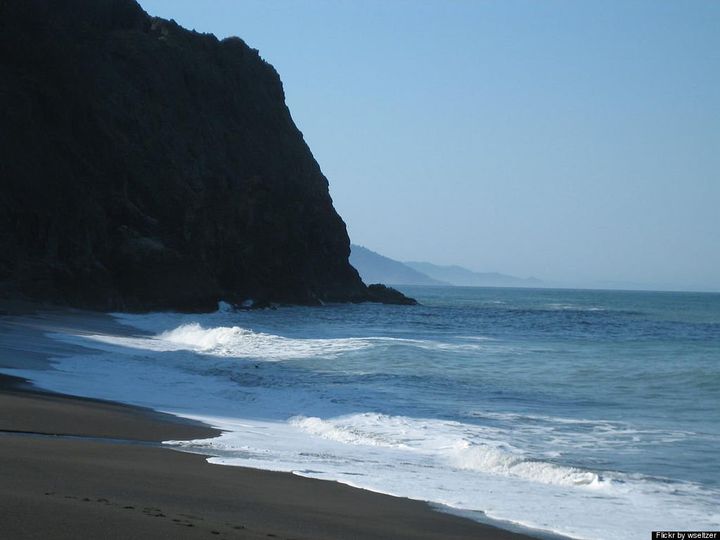
A coastline of purple flowers, long green grasses, and neatly tide-swept black sand beaches give California's Lost Coast the illusion of eerie perfection. "A secluded camper's paradise," one might think. The eagles soaring gracefully above the rolling cliffs and roaring sea complete the living postcard, and at the entrance of the dirt road, adventurous spirits burst with excitement for what lies ahead.
A relatively short drive from Highway 1, the Lost Coast, also recognized as King Range National Conservation Area, is a roughly 60-mile stretch of dense, rugged terrain that backpacking purists and adventure seekers long to explore. It is the only stretch on the entire California coastline that the Highway 1 does not touch, which makes it even more enticing for those wandering souls searching for societal escape.
The problem for the common West Coast traveler, however, is the threat of heading into the Lost Coast and becoming, well, lost.
To access the Lost Coast via the southern entrance, one must navigate a 14-mile, axle-cracking road that snakes its way down the hills hugging the coast. Though it is suggested that you arm yourself with a 4x4 SUV or truck to challenge the road (and nothing but a 4x4 when there is the threat of rain), humans have a history of defiance, particularly against nature (and common sense).
"We should be fine, right?" I asked my friend as we stare down road, shadowed by a tunnel of monster trees and sheer drops a few feet from the road.
"Sure," he said, wiping a smudge of dirt off his little Civic. He put his sunglasses back on his head, peered into the cloudless sky, then walked to the edge of the drop. "Yeah, we'll be fine. Why not?"
Cool sea air flowed through the open windows as we meticulously guided our way down the steep hills, dodging potholes and slicks of mud where constant shadows never let the ground dry. Our little car had been worked hard on the first half of our month-long camping trip up the Pacific Coast, and began to smell of burning rubber, rumbled and rattled through the first half, so we gave it a breather and took in the view.
From the top, it was easy to see how developers avoided this stretch of coast. Developers of Highway 1, arguably the most beautiful stretch of road ever cut and paved, conquered the rugged Big Sur stretch of road south of the San Francisco in the 1930s, but they couldn't touch the Lost Coast. Not then, not now. Too steep, too costly, too rough, developers simply went around it, as cars still do today, often without a second thought.
Afterthoughts, though, spawn lawlessness.
After passing one SUV head out of the park, the Civic sputtered into a clearing below with a state park information sign nearby and an out-of-place yellow traffic sign a few feet beyond that.
"What is that?" my friend asked as he circled a spray of holes in both signs, some larger than others. "They look like bullet holes."
On cue, a monstrous red truck came wheeling around the corner, swerving around us with violent glares and a rev of the engine. The seclusion of the park, though generally safe for backpackers and hikers, also attracts Humboldt Country marijuana farmers because of its difficulty to access, and therefore, police.
Minutes after the truck had turned down a road that led to the beach and disappeared in a cloud of dust, we heard it:
Bang! Bang!
The shots echoed through the hillsides. Our tents hadn't even made it out of the trunk before the Civic was humming back up the road.
"Well, at least we know what the holes were, and who put them there," I said.
Stopping at a small lookout on the hill, we gazed down upon the clearing and the black beach below and watched the truck tear circles through the sand. Most hikers' stories from the Lost Coast, it appears, seem to end in a sense of defeat. The rain, the rough hikes, the unforgiving cold and the general nature of the place usually mount to send visitors crawling back home for a hot shower and a warm meal.
In some ways we were lucky, managing to escape the Lost Coast's teeth before it clinched its jaws. But that didn't stop us lingering for a while on that lookout, wondering what kind of beauty we'd have found below. Between our panting car and the outlaws carving up the beach below, though, we had walked into the Wild West without even bringing a knife to the gunfight.
But I knew there'd be another chance on another day. Despite the brevity of our visit, it became clear on that June afternoon that the Lost Coast will remain lost for generations to come.
Whether you're a backpacking purist, an adventurer, a curious day-tripper, or a gun-wielding-monster-truck-madman, when you're there, you play by nature's rules. In a strange irony, it is this defiance against human intervention and change that is the Lost Coast's most endearing quality.